
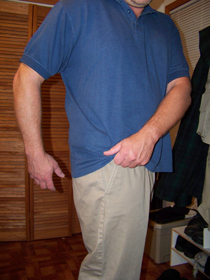
When lifting a shirt to reach a concealed gun, reach all the way across your stomach and grab the hem.
There's that feeling in your gut. For whatever reason you turn just in time so see someone coming out of the shadow near your car. Your heart rate spikes as you see something that looks like a knife at the same instant you realize there is no way to make it to the relative safety of your vehicle or back to the building. The number of options is shrinking with each of the stranger's deliberate steps.
In your most confident voice you command, "STOP! Stay away from me." There is no response, except that the stranger's pace quickens. Your mind races as you calculate the distance, look for cover and again think of your dwindling options before finally reaching for your concealed gun. The stranger sees you move, but he has already committed to the attack and bolts forward. You step off line, looking for cover, trying to create distance as your gun hand finds... a handful of shirt, or the hem of a jacket or some stupid cord lock attached to the bottom of your windbreaker.
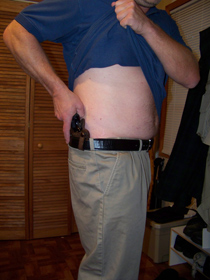
Lift high and fast to get the shirt totally away from the concealed gun.
It's your cover garment! That thing that worked so well keeping your pistol hidden is now robbing you of the precious seconds you need to clear leather, get on target and fire the rounds that will save your life.
Don't let your final thought be, "Damned jacket!" If you don't practice drawing from concealment you are only halfway prepared for a deadly force incident. If you carry a gun because you want to be ready for anything. You had better be ready to draw the concealed gun when you need to. That means you need gun training. If you can't do it at the range, then use dry practice at home to make sure you can clear the holster and get your gun into the fight.
Firearms trainers love to talk about mindset; the mental preparation you need to take the fight to the enemy. That mindset should also include a review of your gear; a mental inventory, if you will. The cover garment is part of your gear.
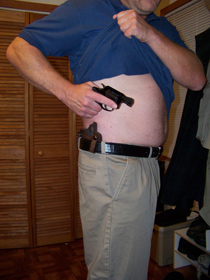
With the shirt totally out of the way, you have a clear path to the target.
Before you leave the house make some mental notes. What kind of cover garment are you wearing? Does it inhibit access to your firearm? What do you need to do to clear that garment and bring the gun on target? Have you practiced any of it?
Much to the chagrin of my children, I can often be seen in the summer months wearing a Hawaiian shirt. I'm not so much concerned about the color and print of the fabric as I am the cut. The shirt is designed to be worn untucked. Combine that with my inside-the-waistband style of carry and my concealed gun is hidden quite nicely in the summer months.
My preferred method of drawing is to reach across my body with my left hand, grabbing the shirt near its hem just above my right front pocket and yanking the material up as I reach for a firing grip on the pistol with my right hand. Yes, this exposes a fair amount of my pasty-white skin, but when it comes time to draw my pistol, modesty is the last thing on my mind.
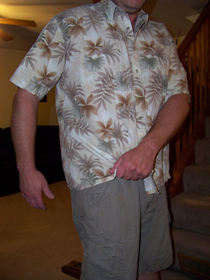
A nice Hawaiian shirt can cover even a full-sized Glock 22.
Luckily I am an untucked shirt kind of a guy. I like polo shirts and other garments that are not quite formal. This draw works well for all of these as well. It also works for those who wear their shirt tucked in with a tuckable IWB holster.
Some prefer to lift the shirt with their firing hand and if that works for you and you practice enough to build the muscle memory you need, then go for it. The key is to gun training. And to know the skills you need to bring that concealed gun to bear.
Clearing a jacket or vest is another skill entirely. In most cases, the jacket is too long or bulky to yank up cleanly. So you have to swing it open. What if it is zipped? Buttons could be a real pain at a time like this. Snaps would be nice.
Let's take the fasteners individually because you must defeat them first. Once you do that the clearing movement is pretty much the same.
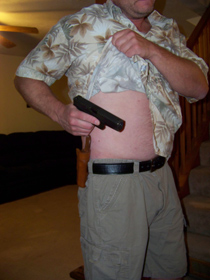
A good cover garment must cover first, but you need to clear it for the draw.
I try to avoid them. But if you must wear a coat with buttons open those buttons as the first inkling of trouble. You might get a bit cold or you might make a fashion faux pas, but the ability to get to your weapon is infinitely more important than anything else. So, open the buttons and put your hands in your pockets to hold the coat closed in front of you if you need to keep out the cold air.
Add a longer zipper pull if you can. The easiest way is to attach a split-ring key ring of some sort to an extension you will use as a handle. To get the best possible speed, reach up to about your heart level with your left hand and grab a handful of coat. Grab your extended zipper pull with your right hand and, keeping your left hand in place, yank down to open the zipper. Remember, when you get to the bottom and feel the zipper open, to pull your right hand to the right. This insures the zipper is all the way open and begins the clearance motion that will get the jacket away from your pistol.

A sports coat is a great cover garment, but make sure you open the buttons at the first sign of trouble.
Quickly opening snaps is very similar to working the zipper, except for the fact that you need to grab closer to the coat's opening with your left hand and position your right hand just below your left. Then pull your hands apart, making certain your pull far enough to break the bottom snap.
You need to get that garment out and behind your concealed gun. Once the buttons, zipper or snaps are defeated, grab the garment and thrust your hand back by violently raising your bent elbow. This keeps your hand close to the side of your body, ready to get a firm grip on the pistol.
One trick some trainers will share is to put a small weight in your right jacket pocket. As you swing the coat the weight cuts a nice arc, carrying the garment out and away from your body. Remember, you want the garment back far enough to give you unfettered access to acquire a firing grip and present the gun. It takes practice and like all other firearms training skills, it is perishable.

To access the gun, run your gun hand straight back, lifting your elbow to keep your hand close to the body to begin your draw. Bit of weight in the coat pocket will really help move the material.
I understand that some shooting facilities will not allow you to draw from the holster on the firing line. But the reality is this gun training might be better off done in your home as dry practice. Here is why. If you constantly train to draw from the holster and squeeze the trigger, you might do that when you don't need to. What if your assailant, upon seeing you present your concealed gun, decides to surrender and your training has ingrained the idea that you must shoot?
The better training is to draw from concealment, verbalize and make a conscious decision to press the trigger. Do this as dry practice in your basement or living room and your family members may roll their eyes, but you will be building the skills you need to survive.